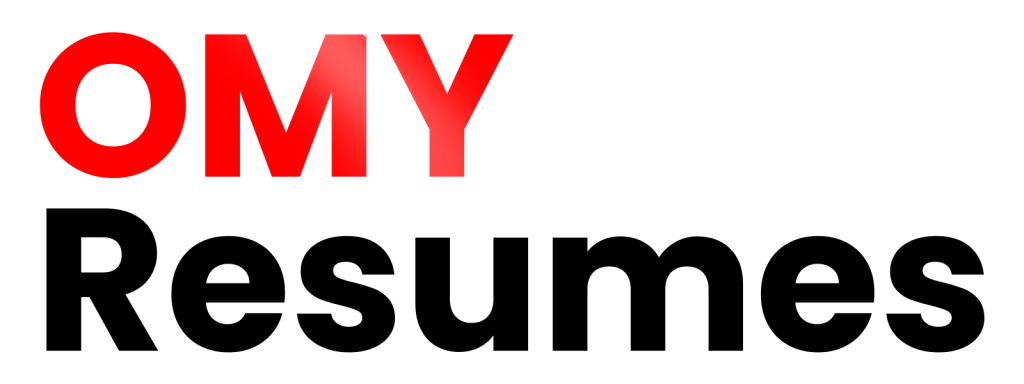Resume Writing: DIY vs. Professional Service What Canadian Job Seekers Need to Know in 2025
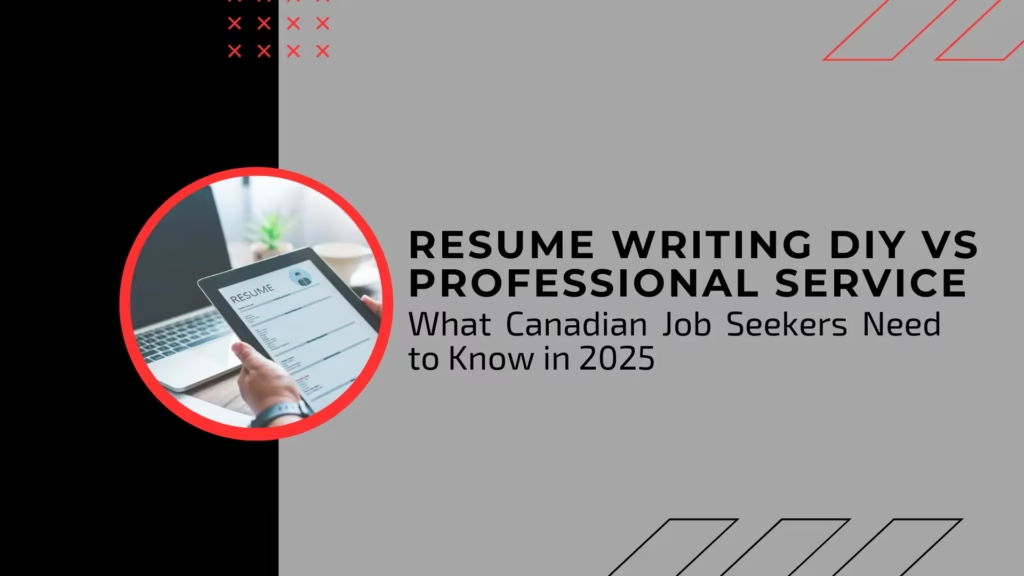
Crafting a strong resume has never been more important for Canadian job seekers. The 2025 labour market is shifting fast — more roles are going hybrid or remote, applicant tracking systems (ATS) are becoming more advanced, and employers across Toronto, Vancouver, Calgary, Ottawa, and Montreal are receiving two to three times more applications than they did before 2020 (Job Bank Canada). Yet many qualified candidates still struggle with the same frustration: “I’m applying everywhere, but no one is calling me back.” In a competitive market where both humans and algorithms decide whether your resume moves forward, the question becomes: Should you write your resume yourself, or hire a professional? This is not a one-size-fits-all answer. Both DIY resume writing and using a professional resume service come with unique advantages, limitations, cost considerations, and time implications. With new AI tools like ChatGPT and automated resume builders emerging, job seekers often feel torn. As a Canadian authority in this space, OMY Resumes helps thousands of applicants — from entry-level graduates to senior executives — navigate these decisions. This comprehensive guide breaks down the pros, cons, examples, myths, trends, and real-world scenarios to help you choose the right approach. Whether you’re targeting a competitive Toronto tech role, a Calgary engineering job, or a leadership position in Vancouver, understanding this decision can dramatically affect your job search results. DIY Resume Writing vs. Professional Resume Services (Canada): Complete Breakdown Below, you’ll find the full comparison, plus actionable insights to help you determine which direction suits your career goals, budget, and timeline. Why This Debate Matters in the 2025 Canadian Job Market The resume landscape in Canada has changed significantly. Hiring managers now expect: And because of AI-generated content flooding job markets, recruiters are becoming more skeptical of generic-sounding resumes that lack depth. Meanwhile, cities like Toronto, Montreal, and Vancouver have fierce competition in IT, healthcare, finance, engineering, and professional services — meaning the quality of your resume directly influences your callback rate. This is where choosing the right resume-writing approach becomes critical. DIY Resume Writing Pros, Cons, and Best Use Cases DIY resume writing is still the most common approach among Canadian job seekers. Let’s break down when it works — and when it doesn’t. Benefits of Writing Your Resume Yourself 1. It’s Cost-Effective For students, recent immigrants, and unemployed job seekers, cost is a major factor. DIY resumes allow you to create something at no financial cost beyond your time. 2. You Maintain Full Control Over the Content Some job seekers prefer to express their voice, story, and personality directly. If you’re a strong writer, this can work to your advantage. 3. You Can Update It Anytime You don’t need to wait for turnaround times or revisions. If you’re applying to many roles, DIY gives you flexibility to adapt your resume instantly. 4. You Learn Valuable Career Skills Crafting your resume helps you: These skills are useful during interviews and networking conversations. Downsides of DIY Resume Writing Despite its benefits, DIY resumes come with significant challenges — especially in the 2025 job market. 1. You Might Not Know What Recruiters Are Looking For Most job seekers write resumes based on what they think employers want. But hiring managers look for: A DIY resume often lacks this precision. 2. ATS (Applicant Tracking System) Errors Are Common The top reason Canadian job seekers don’t get callbacks? Their resumes never pass ATS scanning. Common DIY mistakes include: A study by LinkedIn shows that over 75% of resumes never get seen by a recruiter due to ATS filtering. 3. It’s Hard to Be Objective About Yourself Many job seekers struggle to: Professional writers are trained to extract these insights quickly and strategically. 4. Risk of Sounding Generic With AI Tools Like ChatGPT AI resume tools can help with formatting and ideas, but they: Recruiters can now detect AI-generated content easily. This puts DIY users at risk of sounding unoriginal. Best-Suited Candidates for DIY Resume Writing DIY resume writing may work well for: If affordability is a concern, consider supplementing DIY with Career Consultation from OMY Resumes: Professional Resume Services Pros, Cons, and When They’re Worth It If you want a competitive advantage — particularly for Toronto, Vancouver, Calgary, Ottawa, or Montreal markets — working with a professional resume service can dramatically improve results. Benefits of Working With a Professional Resume Writer (Canada-Focused) 1. Industry-Specific Expertise Professional writers understand what Canadian employers in IT, Healthcare, Finance, and Engineering expect.Examples: OMY Resumes offers industry-specific pages such as: 2. ATS-Friendly Formatting and Optimization Professional writers know how to craft resumes that pass the ATS screening used by: This dramatically increases your chances of getting seen by a human. 3. Strategic Keyword Optimization A professional identifies keywords in: and integrates them naturally — not stuffed or artificial. This is essential for: 4. You Get a True Professional Narrative Not Just a List of Tasks Professionals build: This improves both resume and LinkedIn optimization: 5. Saves You 10–20 Hours of Work Most job seekers spend days — sometimes weeks — rewriting, formatting, and editing their resumes. Professional writers deliver polished drafts quickly, helping you start applying sooner. 6. Results Are Often Immediate Many clients report: This is especially true when combined with: 7. A Professional Resume Is an Investment, Not an Expense Research from Monster.ca shows that job seekers with professionally written resumes are 32% more likely to land interviews. Over a lifetime, this can lead to: Downsides of Professional Resume Writing 1. It Requires an Investment Quality services come with a cost, typically reflecting expertise, industry specialization, and time spent customizing content. However, the return on investment often outweighs the upfront price. 2. Some Providers Use Templates or Outsourced Writers (Not OMY Resumes) Not all resume writing companies are equal. Some: OMY Resumes uses local Canadian writers with expertise across industries and provinces. 3. Requires Communication and Collaboration A strong professional resume depends on: Not all job seekers are comfortable sharing details of their career journey — but the results are
Why Professional Coaching Works: The Real Benefits of Career Consultation for Canadian Job Seekers in 2025
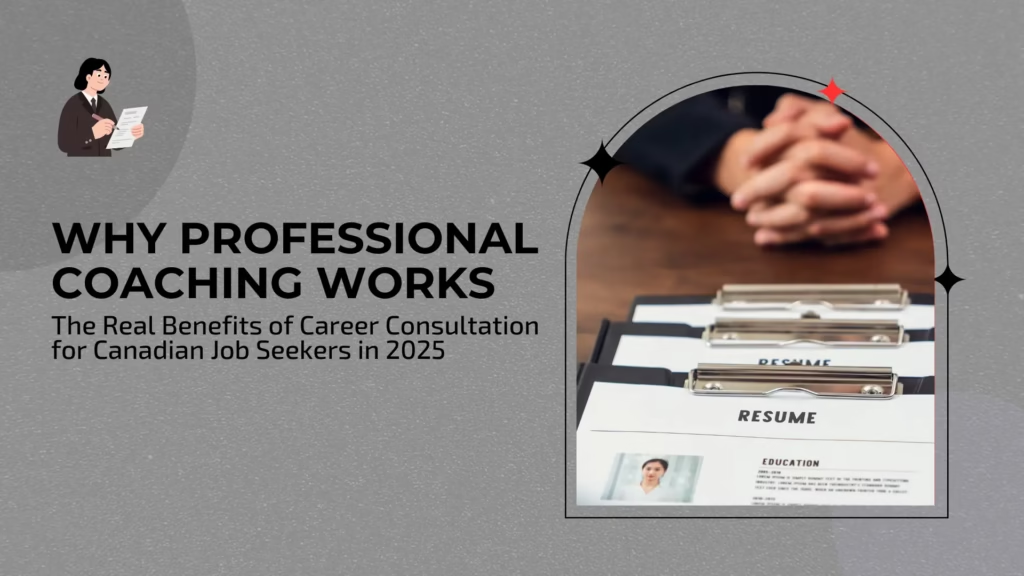
Navigating the Canadian job market in 2025 feels very different than it did even five years ago. Competition is fierce, applicant tracking systems (ATS) have become more sophisticated, and employers expect job seekers to present polished resumes, compelling cover letters, and well-optimized digital profiles. Add in the rise of AI resumes, evolving resume trends for 2025, and shifting hiring expectations across cities like Toronto, Vancouver, Calgary, Montreal, and Ottawa and it’s no surprise many applicants feel overwhelmed. This is where professional career coaching becomes more than a luxury it becomes a strategic advantage. Professional career consultation helps Canadians understand what employers really want, how to position their experience effectively, and how to communicate their value with confidence. Whether you’re a newcomer trying to break into the market, a mid-career professional aiming for a promotion, or an executive preparing for leadership roles, working with a coach shortens your job search and increases your success rate. Agencies like OMY Resumes specialize in customized support, including. These services are specifically designed for Canadian hiring standards something generic templates or AI tools cannot replicate. This article breaks down why professional coaching works, backed by examples, Canadian job market insight, trends for 2025, and real benefits for job seekers across all industries. The Evolution of Career Coaching in Canada Career coaching used to be misunderstood many people saw it as something “extra” or only for executives. But in 2025, it has become a mainstream strategy for job seekers wanting personalized guidance in an unpredictable market. AI Has Changed the Job Search Coaching Helps You Adapt With the growth of ChatGPT, resume builders, and AI screening tools, many job seekers assume technology can replace strategy. But AI often creates: Professional coaches help job seekers use AI smartly, without falling into these traps. Instead of depending on tools, you learn how to strategically tailor your resume, LinkedIn, and interview responses to what Canadian recruiters actually evaluate. Canadian Employers Expect More Personalized Applications According to recent hiring insights from LinkedIn and Statistics Canada, recruiters now focus more on: This is why industry-tailored support, like is so effective it aligns your documents with real recruiter expectations. The Top Benefits of Professional Career Consultation in 2025 Career consultation offers structured guidance, expert insights, and personalized strategies that help job seekers outperform other applicants especially those relying solely on DIY resumes or AI tools. Benefit #1 Expert Clarity on Your Career Direction One of the biggest barriers for Canadian job seekers is not knowing which direction to take. Many clients say things like: A professional coach helps you determine: This clarity saves months of job searching and prevents frustration from applying to roles that aren’t aligned with your background. Benefit #2 A Stronger, ATS-Friendly Resume That Actually Gets Seen ATS-friendly resumes are more crucial than ever. In 2025, over 90% of Canadian employers use ATS scanners (Job Bank Canada). Yet many job seekers still use outdated formats or generic builder-generated documents. A proper, professional resume should: This is where expert support like OMY Resumes’ becomes invaluable. Writers and coaches ensure your resume meets employer expectations and passes ATS screenings in competitive markets like Toronto, Calgary, Ottawa, and Vancouver. Benefit #3 Personalized Job Search Strategies That Save Time Instead of applying blindly to dozens of postings, professional coaching helps you build a targeted job search plan, including: This strategic approach significantly lowers job search time and improves callback rates. Benefit #4 Industry-Specific Positioning for Canadian Employers One of the top reasons job seekers struggle is that they are not positioning themselves correctly for their industry. For example: Generic resumes fail because they don’t speak the language of the industry professional coaches make sure yours does. Benefit #5 Complete LinkedIn Optimization for Better Visibility LinkedIn is now a requirement, not an option. In Canada, over 80% of recruiters use LinkedIn to pre-screen candidates. Yet many job seekers: A coach makes sure your profile is fully optimized, especially when paired with OMY Resumes’ dedicated This boosts: Benefit #6 Stronger Communication Skills for Interviews Interview preparation is one of the most undervalued aspects of the job search yet it’s often the deciding factor. Professional coaching helps you: is designed to help job seekers deliver polished, professional responses that reflect real competency not memorized scripts. Benefit #7 A Polished, Professional Brand Across All Application Materials Your resume, LinkedIn profile, and cover letter should tell the same story but most people’s documents feel disconnected. A career coach helps you create a consistent personal brand, including: This is especially important for competitive fields like executive leadership, finance, engineering, and IT. To help achieve this consistency, many clients also use or build a personal portfolio using perfect for creative, IT, design, and marketing roles. Benefit #8 Increased Confidence and Reduced Job Search Anxiety The emotional toll of job searching is real. Many clients come to coaching after months of struggling with: Professional coaching offers: This reassurance alone can transform the job search experience. Benefit #9 Access to Knowledge About Canadian Job Market Trends Canadian job trends change every year coaching keeps you informed. Resume Trends 2025 A coach helps you incorporate current trends, such as: Hiring Trends Across Canadian Cities Each market behaves differently: A coach guides you toward roles that match your strengths and are in demand in your city. Benefit #10 Faster Job Search Results (Real Case Examples) Career coaching works and real examples show why. Case Study: IT Professional in Toronto An IT specialist spent 4 months applying with no results.After OMY’s resume overhaul and LinkedIn optimization, plus two coaching sessions, he received: Case Study: Newcomer Nurse in Calgary A healthcare newcomer had strong experience overseas but struggled with: After career consultation + a healthcare resume rewrite, she secured a hospital role in under 45 days. Case Study: Marketing Manager in Vancouver This client felt “stuck” after a layoff. Coaching helped her: She landed a role with a 15% salary increase. The Hidden Pitfalls of DIY Resumes and AI-Generated Documents In 2025, many people still
Virtual Hiring Trends What Employers Look for in 2025 – New HR Practices
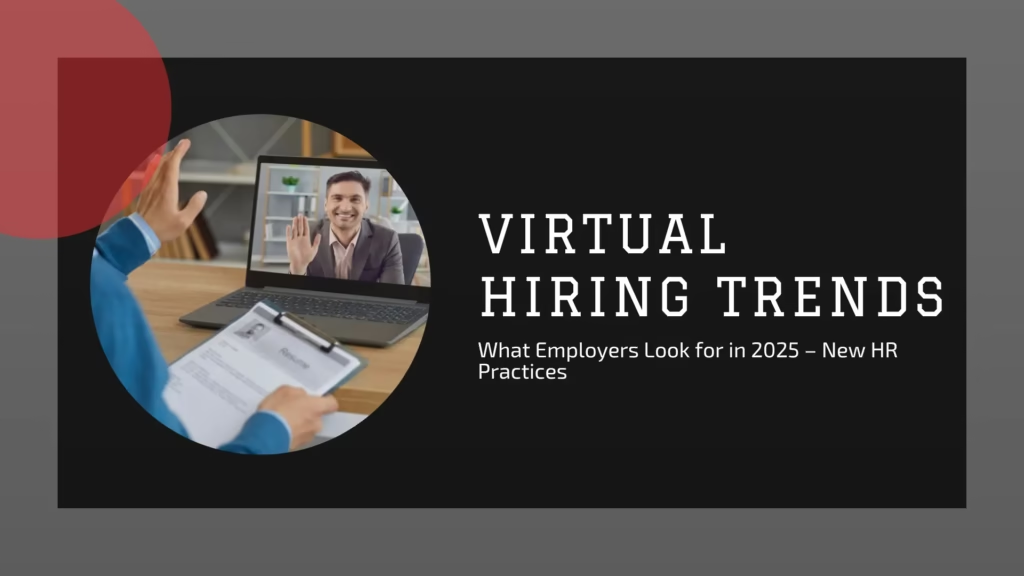
Introduction The Canadian job market is evolving rapidly, and 2025 is shaping up to be a pivotal year for virtual hiring. As companies across Toronto, Vancouver, Montreal, and Calgary embrace hybrid and fully remote work models, understanding the expectations of employers has never been more critical. Job seekers are no longer judged solely on qualificationsthey must now navigate advanced digital recruitment tools, AI-driven applicant tracking systems (ATS), and online professional branding. For Canadian professionals, this shift means that resumes, cover letters, and LinkedIn profiles must be optimized for both human and machine readers. Traditional methods are no longer enough. Employers are seeking candidates who demonstrate adaptability, digital literacy, and soft skills through virtual platforms. This post explores emerging trends, actionable strategies, and practical tips to ensure your application stands out in 2025, offering insights directly applicable to the Canadian job market. Understanding the Shift in Virtual Hiring Practices Why Virtual Hiring is Here to Stay Virtual hiring has moved from a temporary solution to a permanent feature of the Canadian workplace. Companies like Shopify, RBC, and Telus have invested heavily in digital recruitment platforms, indicating a long-term commitment to remote-friendly hiring. For job seekers, this means mastering virtual interviews, online assessments, and digital networking is no longer optionalit’s essential. The Role of Technology in Recruitment AI-powered tools, such as ChatGPT for resumes and automated screening software, are transforming the hiring landscape. Employers use these tools to filter resumes based on keywords, analyze writing style, and even predict cultural fit. Canadian professionals must now produce ATS-friendly resumes that meet both algorithmic and human standards. Increased Emphasis on Digital Presence A strong online presence can tip the scales in your favor. LinkedIn optimization, personal portfolio websites, and professional social media profiles are increasingly scrutinized by recruiters. In 2025, a candidate’s digital footprint is often as important as their resume. Top Virtual Hiring Trends for 2025 AI and Automation in Resume Screening AI is no longer futuristicit’s the standard. Employers in Toronto and across Canada rely on software to parse resumes for key skills, certifications, and experience. Tip: Include industry-specific keywords and action verbs in your resume to improve visibility. to ensure your application passes ATS checks. Video Interviews and Digital Assessments Video interviews are replacing initial phone screens. Employers look for candidates who can communicate clearly, demonstrate problem-solving skills, and show cultural fit online. Consider recording practice sessions and using professional lighting to convey confidence. Remote Work Skills Are a Must Virtual hiring increasingly favors candidates with remote work experience, self-management skills, and proficiency with digital collaboration tools (Zoom, Slack, Asana). Highlight these in your resume and cover letter to align with current trends. for examples tailored to remote roles. Diversity, Equity, and Inclusion (DEI) Initiatives Canadian employers prioritize DEI more than ever. Candidates who demonstrate awareness and engagement in inclusive practicesthrough volunteering, initiatives, or professional developmentstand out. Micro-Credentials and Continuous Learning Short courses, certifications, and industry-specific training are increasingly valued. Highlight micro-credentials on your resume and LinkedIn profile.. Employer Brand and Candidate Experience Companies now evaluate candidates not just on skills, but also on their experience interacting with the company online. This means your email communication, online portfolio, and social media engagement can influence hiring decisions. can help showcase your professional work effectively. Key Skills Employers Seek in 2025 Digital Literacy Basic proficiency in software tools, cloud platforms, and AI applications is expected. Employers increasingly seek candidates who adapt quickly to emerging technologies. Communication and Collaboration Remote work demands strong digital communication skills. Employers look for candidates who can collaborate asynchronously, write clearly, and manage digital meetings effectively. Critical Thinking and Problem Solving The ability to analyze data, make decisions independently, and solve complex problems remotely is a highly sought-after skill. Emotional Intelligence and Adaptability Employers value candidates who navigate change gracefully, handle stress, and maintain positive team dynamics in virtual environments. Creating ATS-Friendly Resumes for 2025 Optimize for Keywords Include job-specific keywords naturally throughout your resume. For example, if you’re in IT, mention certifications like CompTIA, AWS, or Agile methodologies. Structured Formatting Avoid complex designs that confuse ATS software. Use clear headings, bullet points, and standard fonts. specialize in creating ATS-friendly formats. Tailor for Each Application Customize your resume for each role by aligning experience with the job description. Highlight achievements with measurable outcomes. LinkedIn Optimization Tips Complete and Professional Profile Include a professional photo, headline, and summary. Emphasize skills, certifications, and achievements. can boost your visibility. Engage and Network Post insights, comment on industry news, and join relevant groups. Recruiters actively scout talent through LinkedIn in 2025. Recommendations and Endorsements Collect endorsements for key skills and ask colleagues for recommendations to strengthen credibility. Cover Letters That Stand Out Personalize for Each Employer Address the hiring manager by name, mention the company’s mission, and explain why you’re a perfect fit. Demonstrate Remote Readiness Showcase your experience with digital tools, virtual collaboration, and independent work. Highlight Achievements Use concrete examples that demonstrate measurable results. can craft compelling, tailored letters. Virtual Interview Preparation Master the Technology Test your camera, microphone, and software beforehand. Consider for mock interviews. Professional Environment Choose a quiet, well-lit space. Minimize distractions and maintain eye contact with the camera. Practice STAR Responses Use the Situation, Task, Action, Result method to answer competency-based questions clearly and confidently. Industry-Specific Hiring Insights IT and Technology Focus on cybersecurity, cloud computing, and software development skills. Employers expect candidates to demonstrate continuous learning through certifications. Healthcare Highlight telehealth experience, digital patient records proficiency, and adaptability to virtual consultations. Finance Emphasize data analysis, regulatory knowledge, and digital reporting tools. Engineering Showcase remote project management, CAD software skills, and virtual team collaboration. for tailored solutions. Mistakes to Avoid in Virtual Hiring Canadian Job Market Data 2025 According to, remote job postings have grown by over 25% since 2023, with Toronto, Vancouver, and Montreal leading the trend. The most in-demand skills include digital literacy, cloud computing, and communication skills. For job seekers in Ottawa, Calgary, and Edmonton, emphasizing virtual collaboration and flexibility is essential. Step-by-Step
Phone Interview Tips: Making a Strong First Impression in Audio‑Only Interviews
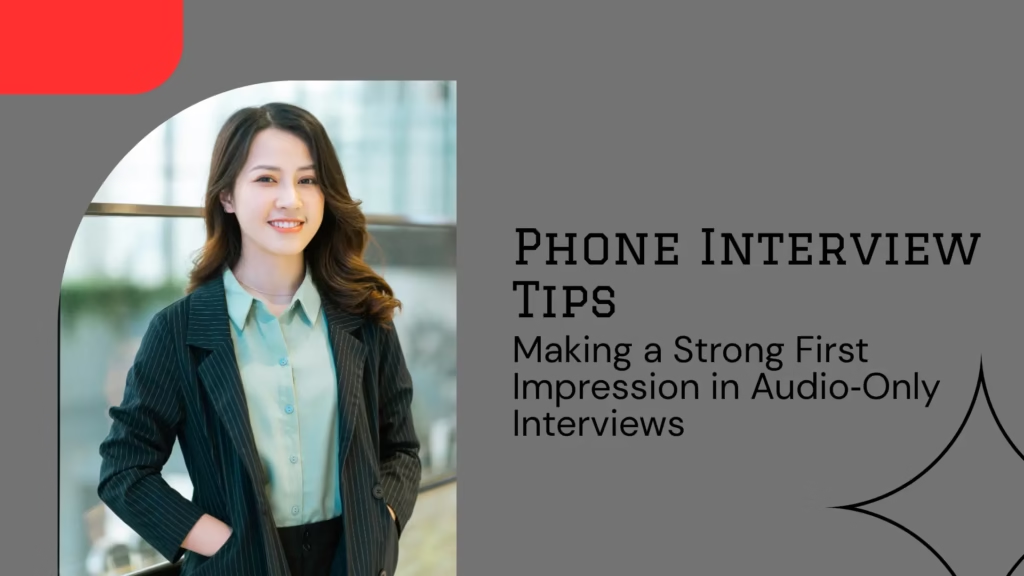
In today’s competitive Canadian job market, especially across hubs like Toronto, Vancouver, Montreal, and Calgary, mastering the phone interview is more crucial than ever. With many hiring processes starting remotely, audio-only interviews serve as a vital filter for recruiters. Whether you’re seeking roles in IT, healthcare, finance, or engineering, how you sound on the phone can determine whether you move forward or get passed over. In this comprehensive guide, OMY Resumes a trusted authority for resume writing Canada, ATS‑friendly resumes, and interview preparation coaching shares expert advice on making an outstanding first impression during a phone interview. We’ll cover strategic preparation, voice techniques, common pitfalls, real-world examples, and step-by-step guidance tailored to Canadian job seekers in 2025. Why Phone Interview First Impressions Matter (Especially in 2025) Audio-only interviews are becoming more common for a few key reasons: However, the downside is that you don’t have visual cues no facial expressions, body language, or on-screen polish. In a phone interview, your voice tone, energy level, clarity, and preparedness carry all the weight. Making the right first impression can be the difference between a callback or being ghosted. For Canadian job seekers navigating the 2025 job market whether recent grads in Toronto, professionals in Ottawa, or executives in Vancouver mastering the phone interview is a critical component of interview preparation. Combine it with a stellar, ATS‑friendly resume, strong LinkedIn optimization, and a tailored cover letter writing strategy, and you’ll dramatically boost your chances of success. Understanding the Canadian Job Market: Why Phone Interviews Are Here to Stay Before we dive into tips, let’s set the scene with insights specific to Canada: Given this context, nailing your phone interview is essential. Below, we break down how to do it effectively. Preparing for the Phone Interview (Pre-Call Strategy) Research the Role and Company Set Up an Ideal Environment Prepare Talking Points Practice Voice & Delivery Understand the Logistics Phone Interview Opening – Making a Great First Impression Professional Greetings Begin the conversation professionally: “Good morning, this is [Your Name] speaking. Thank you for taking the time to speak with me today.” This kind of confident, warm introduction sets a positive tone. Establish Rapport Quickly Clarify Structure Polite yet proactive: “Before we begin, could you share how you’d like to structure today’s call? Should we go through your list of questions first, or would you prefer I walk you through my background?” This shows you’re organized and considerate, a professional touch many Canadian hiring managers appreciate. Mastering Your Voice – Tone, Clarity, and Energy Why Voice Matters Without visual cues, your tone, volume, and inflection become your body language. These factors strongly influence how your first impression is received. Tone Techniques Volume and Clarity Energy Structuring Your Responses – Be Concise and Impactful Use the STAR Method Behavioral questions are common in phone interviews. Use the STAR method (Situation, Task, Action, Result) for clarity: Example (IT role): Keep Answers Focused Use Concrete Data Asking Great Questions – Stand Out as a Thoughtful Candidate Why Asking Questions Matters Interviewers often gauge your interest and fit by the depth and relevance of your questions. Thoughtful questions show preparation, curiosity, and strategic thinking. Sample Questions to Ask Handling Difficult or Unexpected Questions Be Ready for Tough Questions Some common challenging questions in phone interviews include: Strategy for Answering (Finance Role): “Can you tell me about a time you failed?” Navigating Common Phone Interview Mistakes Here are frequent pitfalls Canadian job seekers encounter and how to avoid them: Building Confidence Through Practice – Mock Phone Interviews Roleplay with a Partner Use Professional Coaching Self-Recording and Reflection Iterative Improvement Real-World Scenarios and Case Studies Entry-Level IT Role in Toronto Background: Sara, a recent computer science grad in Toronto, applied for a junior software developer position at a tech startup. After submitting her ATS-friendly resume, she got invited for a phone screen. Preparation: She practiced several STAR stories (course project, internship, hackathon), tested her headset, and set up in a quiet room. Interview: She began with a professional greeting, emphasized her coursework using data (“we reduced load times by 20%”), and asked thoughtful questions about team culture. Her voice was clear, confident, and enthusiastic. Outcome: She received a follow-up video interview and eventually landed the job. She later credited her practice and preparation for making a strong first impression. Mid-Level Healthcare Role in Vancouver Background: David, a registered nurse with 5 years in critical care, applied for a clinical coordinator role in a Vancouver hospital. He had a well-crafted, industry-specific resume built by OMY Resumes’ Healthcare Resume Writing team. Preparation: He worked with a coach from OMY Resumes’ Interview Preparation Coaching service to refine how he described his leadership experiences, using the STAR method. Interview: On the call, David articulated his experience clearly, narrated a story about leading a quality improvement initiative, and asked insightful questions about workflow and interdepartmental collaboration. Outcome: The hiring manager remarked that David’s professionalism and clarity over the phone set him apart. He advanced to an in-person panel interview and secured the role. Senior Executive Role in Finance (Toronto) Background: Maria, a finance executive in Toronto, was targeting a director-level position. She had OMY Resumes revamp her executive resume and LinkedIn profile optimization to align with current resume trends 2025. Preparation: She scheduled a mock interview as part of her OMY Resumes Career Consultation Canada package. They practiced high-stakes behavioral and strategic questions. Interview: During her initial screening, she described how she managed a cross-functional team, delivered cost savings of 15%, and aligned strategy with business outcomes. Her tone was calm, authoritative, and genuine. Outcome: She earned the trust of the recruiter during the phone call and got expedited to a final-round interview. She now credits her refined messaging and voice delivery for positioning her as a leader. Follow‑Up After the Phone Interview Send a Thank‑You Email Within 24 hours, send a concise, thoughtful thank-you email. Key elements: Use Internal and External Content Keep Track of Key Dates Advanced Tips for Senior or Executive Candidates Tailor
Success on Indeed and LinkedIn: Optimizing Job Alerts and Profiles to Get Noticed in 2025
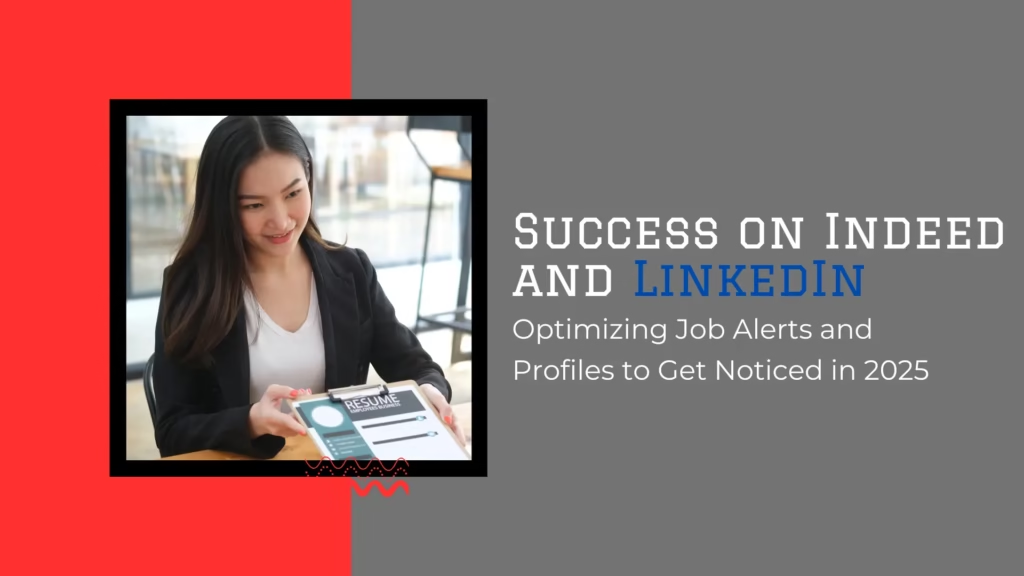
In the highly competitive Canadian job market of 2025, simply posting a résumé and hoping for the best won’t cut it. With the unemployment rate at 6.9% and employment growth slow, job seekers need smarter strategies to stand out. Using job-boards like Indeed and LinkedIn effectively can make the difference between dozens of “no-callbacks” and the interview you deserve. At OMY Resumes, we’re committed to empowering Canadian professionalswhether in Toronto, Vancouver, Calgary or Ottawawith actionable steps to optimise job-alerts and profiles so you can attract the right hiring managers and recruiters. In this article you’ll find practical, real-life tips and step-by-step strategieswhether you’re in IT, Healthcare, Finance or Engineeringalongside mistakes to avoid, success examples and insights into how to align your digital presence with today’s tools such as AI-enabled screening. We’ll also link you to our full suite of servicesfrom our toso you can take your job-search from decent to high-performance. 1. Understanding the Job-Board Landscape in Canada 2025 Why Indeed and LinkedIn matter now Canadian job-market data to know Takeaway: In 2025 you’re a marketer of your own skills, and Indeed + LinkedIn are your storefronts. Let’s optimise them. 2. Setting Up and Optimizing Job Alerts on Indeed Why job alerts matter Job alerts on Indeed are not just passive notifications. They are signals to the algorithm and to recruiters that you are an active candidate. If you set them up correctly, you’ll: Step-by-step guide to effective alerts Optimising alert keywords (with examples) Example scenario Sara, a mid-level marketing professional in Toronto: Tips and common mistakes Tips: Mistakes to avoid: 3. Crafting a Stand-out LinkedIn Profile for Canadian Employers Why LinkedIn optimisation is essential Key areas to optimise Headline Your headline should go beyond your job title. For example: About / Summary section Use 3-4 short paragraphs: Experience section Skills & Endorsements Recommendations Profile Photo & Banner LinkedIn URL & Public visibility Example optimisation scenario Ahmed, an engineering professional in Calgary: 4. Aligning Résumé Content with Job Alerts and Profiles Why alignment matters When you set alerts on Indeed and have a strong LinkedIn profile, your résumé becomes the central document that connects the two. It should echo keywords from alerts and match your LinkedIn profile to create consistency. This is especially critical for ATS-friendly resumes in Canada. Practical steps for alignment Canadian résumé trends for 2025 5. Building and Managing Your Indeed Profile Why your Indeed profile matters Even if you apply directly through LinkedIn, many companies repost on Indeed or use Indeed’s resume database. A well-completed Indeed profile ensures you appear in recruiter searches and your alert setup works effectively. Key sections to complete Tips for maximising recruiter reach 6. Using Alerts and Profiles Strategically for Industry-Specific Searches IT / Tech Sector Healthcare & Life Sciences Finance & Accounting Engineering & Construction 7. Mistakes to Avoid When Using Job Alerts and Profiles Over-generalisation Inconsistent branding Ignoring alerts Ignoring keywords and ATS Lack of follow-up and networking 8. Case Study: From Invisible to Interview in Toronto Meet Jessica, a marketing professional in Toronto aged 29. She was applying to roles via Indeed but getting no response for months. We helped her at OMY Resumes in three steps: Key takeaways: Focused keywords + consistent profile + active alert management = tangible results. 9. The Role of AI, ChatGPT and Digital Screening in 2025 What’s changing How you can use this to your advantage Caution 10. Long-Term Strategy: Building a Job Alert + Profile Ecosystem Why think longer term Even if you land a role, building this system ensures you’re ready for your next move and reduces job-search stress. Components of your ecosystem Beginner to advanced alerts This multi-tier strategy gives you both stability and opportunistic reach. 11. Mistakes to Avoid in the Long-Term Strategy 12. Quick Checklist Before You Submit an Application 13. Measuring Your Success and Adjusting Your Strategy Key metrics to track When to pivot 14. Why OMY Resumes Is Your Partner for Success At OMY Resumes, we specialise in helping Canadian professionals land better roles through precision-written, ATS-friendly resumes, LinkedIn profile optimisation, custom job-alert strategies and career consultation. Here’s how we fit into your job-search ecosystem: Conclusion In 2025’s competitive Canadian job-market, your most important assets are your digital presencethe job alerts you set on Indeed and the professional profile you maintain on LinkedIn. When these are optimised, aligned with an ATS-friendly résumé and continuous activity, you position yourself far ahead of the passive job-seekers. As we’ve detailed: precise alerts, profile optimisation, keyword alignment, and consistent action lead to interviews and results.
LinkedIn Etiquette for Job Seekers in Canada Do’s and Don’ts You Can Use Right Now
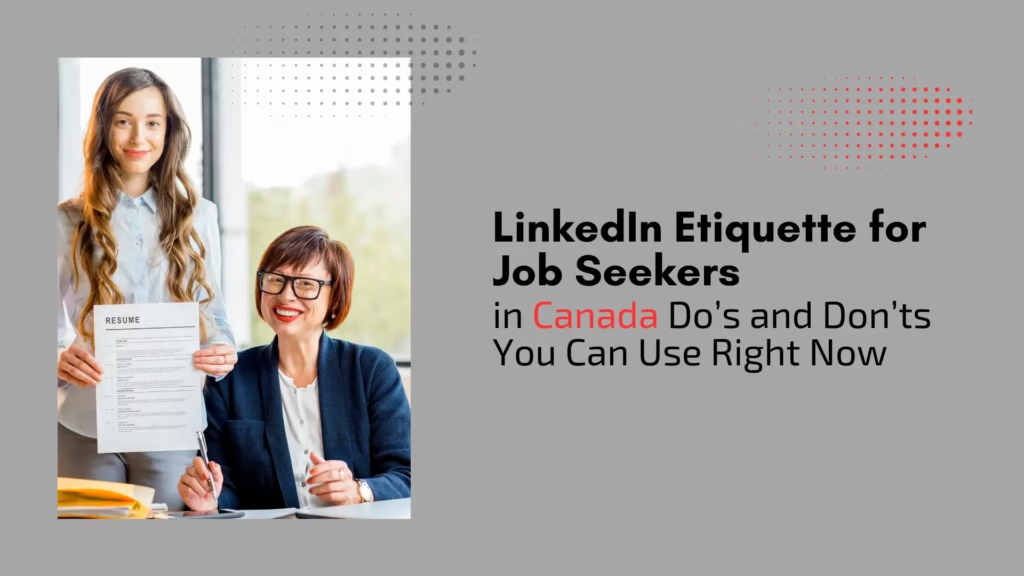
In today’s competitive hiring environment in Canada, you can’t leave your professional presence on LinkedIn to chance. Whether you’re in Toronto, Vancouver, Calgary, Montreal, or Ottawa, recruiters and hiring managers are actively using LinkedIn to screen, evaluate, and connect with talent. According to recent data, around 75 % of job seekers report using LinkedIn in their search for new opportunities If you’re a Canadian-based job seeker in 2025whether you’re in IT, healthcare, finance, engineering or any other fieldthis blog post is your practical guide. We’ll outline the do’s and don’ts of LinkedIn etiquette, show you how to optimise your presence, and demonstrate how your profile, outreach, and behaviour can either support or hinder your job hunt. At OMY Resumes we’ve helped hundreds of candidates refine their online brand, build ATS-friendly resumes and secure interviews. We’ll now show how LinkedIn fits into your broader job-search toolkit (alongside your resume writing Canada, cover letter writing and interview preparation). Let’s dive in. Why LinkedIn Matters for Canadian Job Seekers in 2025 A quick snapshot of the job market The need for etiquette A sloppy or overlooked LinkedIn profile can undo the work you’ve done crafting an ATS-friendly resume or booking a career consultation Canada-based service. On the flip side, a thoughtful LinkedIn profile and strategic engagement can open doors you hadn’t even applied to. Networking on LinkedIn isn’t optionalit’s essential. First Impressions Count – Profile Setup and Optimisation The basics of profile polish You only have moments to make a good first impression. Here are the key elements to get right. Do: Use a professional photo Do: Craft a compelling headline and summary Do: Update your location and customise your URL Do: Use complete sections and achievements Things job-seekers often overlook Don’t: Leave the profile outdated Don’t: Use inappropriate photos or content Don’t: Use buzzwords without proof Network Building – Quality over Quantity Why networking on LinkedIn matters Building connections isn’t just about collecting contactsit’s about meaningful visibility. In Canada’s job market of 2025 your network can lead to referrals and opportunities before roles are even posted. Do: Connect strategically H3 – Do: Engage actively Do: Give before you ask H3 – Don’t: Spam connection requests Don’t: Pitch your services or jobs in your initial outreach Content & Activity – Showcasing Your Personal Brand Why sharing content matters Recruiters and hiring managers often check how you engage on LinkedIn. Are you a passive profile or someone who contributes to the professional community? Do: Share relevant insights and updates Do: Show consistency Don’t: Overshare personal or non-professional content Don’t: Copy-paste generic posts or auto-generate without editing Messaging & Outreach – Asking for Help the Right Way Key rules for LinkedIn messaging How you message someone can make or break a connection. Especially in job search mode, you want to come across as professional, courteous and purposeful. Do: Personalise your messages Do: Be clear about your ask Do: Follow up with gratitude Don’t: Ask for a job straight away Don’t: Send mass templated messages Using Keywords & SEO on LinkedIn – Boosting Visibility Why LinkedIn SEO matters Just like your resume should be ATS-friendly, your LinkedIn profile must be discoverable by recruiters using keyword filters. With Canadian job search trends leaning digital, you’ll benefit from the same kind of optimisation. Do: Use relevant keywords throughout Do: Prioritize your top skills Don’t: Keyword-stuff or use irrelevant terms Employer & Recruiter View – Impressing from the Other Side What recruiters look for Understanding the recruiter’s mindset helps you tailor your profile and outreach. According to best practice content: the key items recruiters examine include: photo, headline, connections, summary, and endorsements. Do: Show social proof and recommendations Do: Show current activity and stability Don’t: Hide gaps or lack of detail Mistakes to Avoid – Common LinkedIn Etiquette Fails Avoid these missteps that can cost you Here are real-world pitfalls and how to avoid them. Mistake #1: Leaving your profile as “open to job” but inactive Mistake #2: Connecting with hundreds of irrelevant contacts Mistake #3: Posting controversial or unprofessional content H3 – Mistake #4: Ignoring your “About” section and leaving it blank Mistake #5: Not tailoring your outreach to Canadian context Industry-Specific Etiquette Tips – Examples for Different Roles Tailored advice by industry Here are scenarios and actionable tips for three major industries in Canada. IT and Tech (e.g., software developer, cloud architect, DevOps) Healthcare (e.g., registered nurse, healthcare project manager) Finance / Accounting / Banking Measuring Results & Iterating – A Step-by-Step Guide How to know your LinkedIn efforts are paying off Here’s a practical 4-step cycle you can apply. Integrating LinkedIn with Your Broader Job-Search Strategy How LinkedIn supports your full job search toolkit Your LinkedIn presence should not sit in isolationit must reinforce the other pillars of your job-search strategy. Example scenario Sarah is a mid-level software engineer in Toronto. She engages the following process: Case Study – A Canadian Job Seeker’s LinkedIn Success From overlooked to in-demand: real-world example BackgroundAhmed, a mechanical engineer with 5 years of international experience, relocated to Calgary and was struggling with job applications in 2024. His resume was okay but his LinkedIn profile was outdated, his network sparse, and his messaging generic. Intervention ResultsWithin 10 weeks: TakeawayThis success highlights the importance of LinkedIn optimisation with a Canadian focus, network building and structured outreachtied to a strong foundation of a polished resume and preparation. Emerging Trends in LinkedIn Etiquette for 2025 What’s new and what to watch in 2025 Micro-content for thought-leadership: Short posts or video updates are gaining traction; job seekers who share industry insights stand out. Hybrid & remote-friendly mentions: When job seekers indicate openness to remote work or Canadian-remote roles, they expand their pool of opportunities. Implications for you Conclusion In 2025 the Canadian job market is more connected, more competitive and more digital than ever. For job seekers in Toronto, Vancouver, Calgary, Montreal or any Canadian region, mastering LinkedIn etiquette is not optionalit’s essential. When you pair a polished LinkedIn presence with your ATS-friendly resume,
Using Instagram and Personal Websites in Your Job Hunt Unconventional Portfolio Ideas
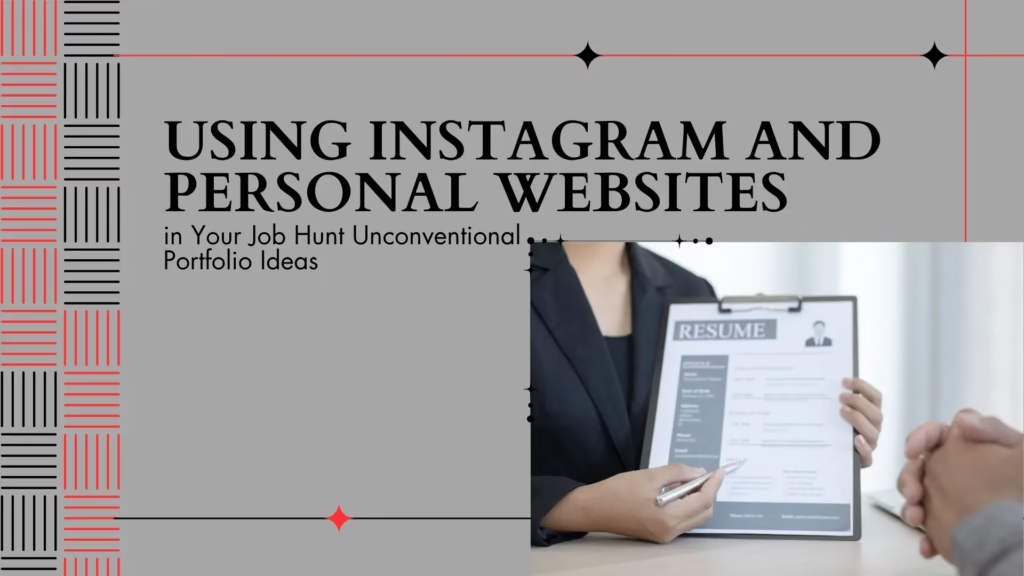
Intro In the fiercely competitive Canadian job market of 2025 building a standout presence beyond the standard résumé is increasingly vital. With unemployment hovering around 6.9 % and job vacancies shrinking across many sectors in Canada, job seekers must find fresh ways to differentiate themselves. One powerful route is to use platforms like Instagram and a personal website as part of your job-hunt toolkit. This is not about gimmicks but about smartly showcasing your skills, personality and adaptability for roles in IT, healthcare, finance, engineering or creative fields. At OMY Resumes we help Canadian professionals with resume services Toronto and across Canada build ATS-friendly resumes, optimize LinkedIn profiles and craft online portfolios that boost callback rates. This blog explores how you can use Instagram and a personal website as unconventional but strategic portfolio tools to complement your résumé writing Canada process, bolster your brand and land interviews faster. Why Unconventional Portfolios Matter for the Canadian Job Market Job-market snapshot: tougher competition means you need more than a resume What a standard résumé lacks A typical résumé provides a list of skills, education and experience – it may show what you’ve done but not always how you did it, what you look like working, or who you are beyond the bullet points. Recruiters and hiring managers increasingly look for evidence of: By integrating Instagram as a curated visual story and a personal website as a live portfolio you provide depth and trust beyond your industry-specific résumé or executive resume tips. Instagram as a Portfolio Tool for Job Seekers Why Instagram fits the job-hunt portfolio strategy Instagram is no longer just for vacation snapshots. For a job seeker it can serve as a dynamic, visual portfolio, especially if you’re in design, marketing, UX/UI, photography, social media, or any role where visual communication matters. Consider: How to setup your Instagram portfolio with intention Examples of how this works for job seekers Such real-world visuals do what a traditional cover letter writing can’t: show you in action, comfortable with digital media, and ready for modern workplace expectations. Building a Personal Website as Your Central Portfolio Hub Why you need a personal website alongside Instagram Your personal website is a digital “home base” that establishes your professional domain, controls the brand narrative and captures deeper content than Instagram allows. It complements your online presence and becomes a link you can include in cover letters, LinkedIn profiles and résumé footers. At OMY Resumes we often guide clients through our portfolio website development service for exactly this reason. Key elements your portfolio website must include 1. Clean homepage Optimising your website for Canadian job search Integrating Instagram + Personal Website with Other Job-Hunt Strategies Building synergy with your résumé and LinkedIn profile You don’t operate in silos. Your unconventional portfolio (Instagram + website) should tie into the broader job-hunt ecosystem: Why this matters for ATS-friendly resumes While a personal website and Instagram won’t show up in an Applicant Tracking System (ATS) scan, they affect what happens after the scan. Once your résumé passes the ATS scan thanks to proper keywords (industry-specific resumes, executive resume tips) your online presence becomes your differentiator. Employers will Google you. If they find a clean professional website and curated Instagram feed, you instantly earn trust and interest. At OMY Resumes we ensure your résumé aligns with ATS standards and then you build this digital layer as your advantage. Trends Driving Portfolio Innovation in 2025 Emerging trends Canadian job seekers need to know What the data says Typical Mistakes to Avoid When Using Instagram/Website for Job Hunt Common pitfalls and how to steer clear Unprofessional content on InstagramIf your Instagram feed is a mix of memes, vacation selfies and work posts you risk damaging your professional brand. Solution: curate a separate account for your professional persona or clean up your current feed.Website without purposeIf your personal website is just a landing page with “Coming soon” and no meaningful content you’ve missed the point. Fill it with at least 3-5 work samples, your story and contact info.Poor alignment between résumé, LinkedIn and portfolioIf your résumé says you’re a data analyst for finance but your website highlights photography and Instagram shows travel blogs you create confusion. Ensure your branding is consistent.Ignoring mobile usersMany recruiters check profiles via smartphone. If your site looks bad on mobile or your Instagram link leads to broken pages you lose credibility.Over-selling instead of showingDon’t write long paragraphs about how “I’m the best at X”. Use visuals, metrics, case studies. On your website: “Reduced onboarding time by 20%” rather than “excellent at process improvement”.Not linking everything togetherIf you build a website but never mention it on your résumé or LinkedIn you lose the chance to drive traffic. On your Instagram bio link to the site. On your LinkedIn “Featured” section include site link. Case Study – Creative Professional in Toronto Example: Sarah’s journey from generic résumé to standout digital portfolio Background: Sarah is a graphic designer based in Toronto seeking mid-level roles in marketing agencies. Her initial résumé followed standard template and she submitted to many roles via portals but received only a handful of interviews.Pain-point: No callbacks, felt like she blended into the pile of “graphic designer – InDesign / Illustrator” applications.Strategy: Step-by-Step Guide to Launching Your Instagram/Website Portfolio 10-Step roadmap for Canadian job seekers Tailoring Strategies by Industry Creative & Design Roles IT & Engineering Roles Healthcare & Finance Roles Measuring Success and Adjusting What metrics to watch How to adjust based on results The Role of a Professional Partner in This Process Why you might partner with OMY Resumes Building and integrating a complex digital portfolio alongside your résumé and job-search strategy can be overwhelming. At OMY Resumes we provide Canadian-focused services to streamline this: Conclusion In today’s Canadian job market where competition is high and traditional applications no longer guarantee visibility, using an Instagram-based portfolio and personal website gives you a strategic advantage. When you pair these tools with professional services like resume writing Canada, LinkedIn
Building an Online Portfolio for Creative Careers: How to Showcase Work That Lands You Interviews in Canada
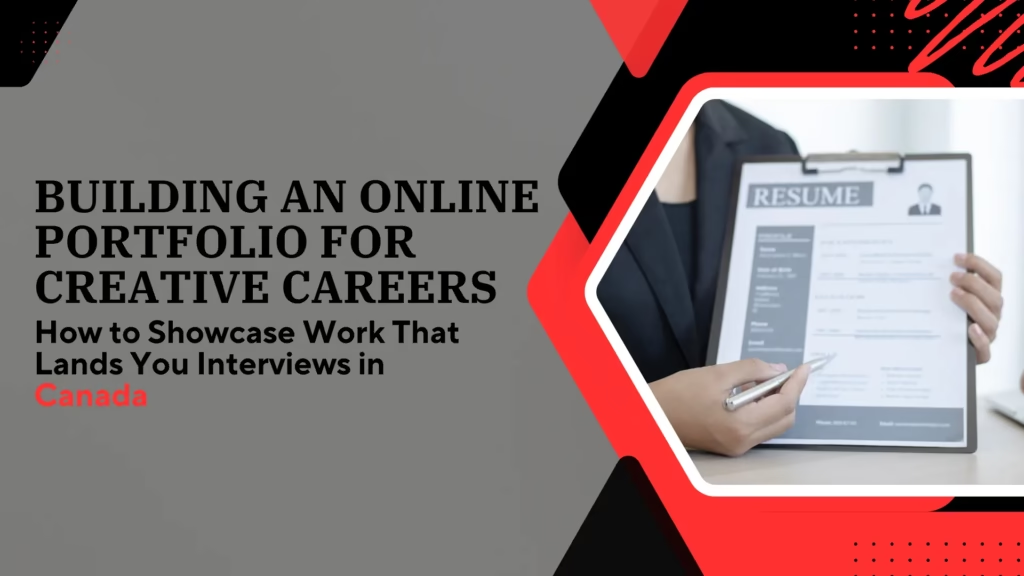
In today’s dynamic job market, a strong online portfolio can be your secret weapon to stand out. Whether you’re a designer, writer, photographer or creative professional in Toronto Vancouver Calgary or beyond, showing your work matters more than ever. At OMY Resumes we’ve helped thousands of Canadian job-seekers upgrade their resumes and personal branding. This post dives deep into how to build and optimise an online portfolio, giving you practical tips, step-by-step strategy, and mistakes to avoid—all while tying in key themes like resume writing Canada, resume services Toronto, LinkedIn optimisation, ATS-friendly resumes, cover letter writing and interview preparation. Why an Online Portfolio Matters in 2025 for Canadian Job Seekers In 2025 the Canadian job market is evolving fast. According to the “Demand for Skilled Talent” report, 84 % of marketing and creative managers report difficulty filling roles requiring design UX or visual production skills. Employers are looking for proof of what you can do, not just a list of roles.An online portfolio allows you to demonstrate rather than describe your creativity—that’s especially important when many applications still get filtered by Applicant Tracking Systems (ATS) before a human even sees them.For job-seekers in creative fields (graphic design, UX, writing, photography, …) in Canada, having a well-structured portfolio website alongside your resume gives you a competitive edge. It shows initiative, digital literacy and a tangible body of work.At OMY Resumes we believe that combining your portfolio with an ATS-friendly resume, strong cover letter, and a LinkedIn profile optimised for your niche is the hallmark of an effective job application today. Understanding the Role of a Portfolio in Creative Careers What a Portfolio Is (and Is Not) A portfolio is more than a PDF or a few images. It’s a curated showcase of your best work, your creative process, your results, and your unique style.It’s not: Why Creative Employers Value Portfolios Portfolio vs Resume vs LinkedIn Profile Key Trends Affecting Creative Portfolios in Canada 2025 Skills-Based Hiring and Portfolio Relevance According to a career insights article for Canada Career Month, Canadian employers increasingly hire for skills rather than titles. A strong portfolio can showcase transferable skills—creativity, problem-solving, digital communication—that go beyond job titles. Remote/Hybrid Work and Digital Presence With more remote and hybrid roles becoming common in Canada, your digital presence—including portfolio—can make or break first impressions. AI, Automation and the Value of Human Creativity Automation is rising in many roles—but creative work remains one of the spaces where human skills matter. Employers in Canada list “creativity and innovation” among the most valued human skills. A portfolio underscores your creative advantage. The Gig Economy, Freelance and Side Projects Many creative professionals in Canada work freelance or take on contract work—portfolio websites are essential for marketing yourself independently and showing versatility and initiative. Step-by-Step Guide to Building Your Online Portfolio Here’s how you can build an online portfolio that complements your resume writing Canada strategy and positions you for creative career success. Define Your Target Industry & Role Choose the Right Platform Curate Your Best Work Organise Your Portfolio Intelligently Add a Personal Brand Story Integrate Resume & Cover Letter Linkage Make Contact and CTA Clear Keep It Updated & Optimised Showcasing Work with Real Examples and Mini-Case Studies Graphic Designer Portfolio Example – Toronto Market Scenario: A mid-level graphic designer in Toronto wants to move into a UX design role.Portfolio Strategy: Writer/Content Creator Portfolio – Vancouver Freelance Market Scenario: A content writer targeting Canadian fintech companies with remote roles.Portfolio Strategy: Photographer/Visual Creator Portfolio – Freelance Across Canada Scenario: A photographer seeking contract work across Canada including Calgary, Ottawa and Montréal.Portfolio Strategy: Optimising Your Portfolio for Search and Hiring Systems Keyword Strategy Link the Portfolio to Your Resume and Other Services Make it Easy for Recruiters and ATS Systems While the portfolio is mostly for human eyes, your resume remains the piece filtered by ATS. However when you send a link or include the portfolio in applications you want: Use Analytics to Improve Performance Common Mistakes to Avoid When Building Your Portfolio Mistake 1: Too Many Pieces, No Focus Putting everything you ever created dilutes impact. Be selective—quality trumps quantity. Lack of Context A set of pretty visuals with no explanation won’t convey your process or results. Always include brief descriptions with client/brief/impact. Neglecting Your Resume & Cover Letter Many creatives focus only on visuals and ignore how the portfolio links to their broader job-search toolkit. Make sure you integrate with your resume writing Canada strategy and mention your ability to craft ATS-friendly resumes, cover letter writing and interview preparation. Ignoring Mobile and Speed A slow-loading or hard-to-navigate site on mobile will frustrate recruiters. Test on phone and desktop. Not Updating or Removing Out-of-Date Work Older projects that no longer reflect your current level can hurt your brand. Keep the portfolio current and remove obsolete items. No Contact or Clear Call to Action If the visitor doesn’t know what to do next (contact you, book a consult, download your resume) you’ll lose momentum. Poor Branding and Inconsistent Design Your portfolio should reflect your personal brand (logo, typography, colour scheme). Random design styles across pieces suggest lack of focus. Portfolio Strategies by Industry and Career Stage Entry-Level Creative Professionals If you have limited client work: Mid-Level Specialists (Designers/Writers/Photographers) Executive-Level or Senior Creative Professionals Freelancers and Side Project Specialists Leveraging LinkedIn, Resume and Cover Letter to Drive Traffic to Your Portfolio LinkedIn Profile Optimisation Your online portfolio and LinkedIn profile must work together. On your LinkedIn: Resume Integration When you submit your resume (using our resume services Toronto or other region pages), include a line near the top or in your header: “Portfolio of selected work available at [URL]”This shows you are more than just a list of skills—you bring tangible results. Cover Letter Alignment In your cover letter (cover letter writing service page), mention a specific project in your portfolio: “As seen in my portfolio (see ‘UX Redesign for XYZ’), I led a team that cut user drop-off by 20 %…”This pulls the
Job Market 2025: Skills in Demand in Canada
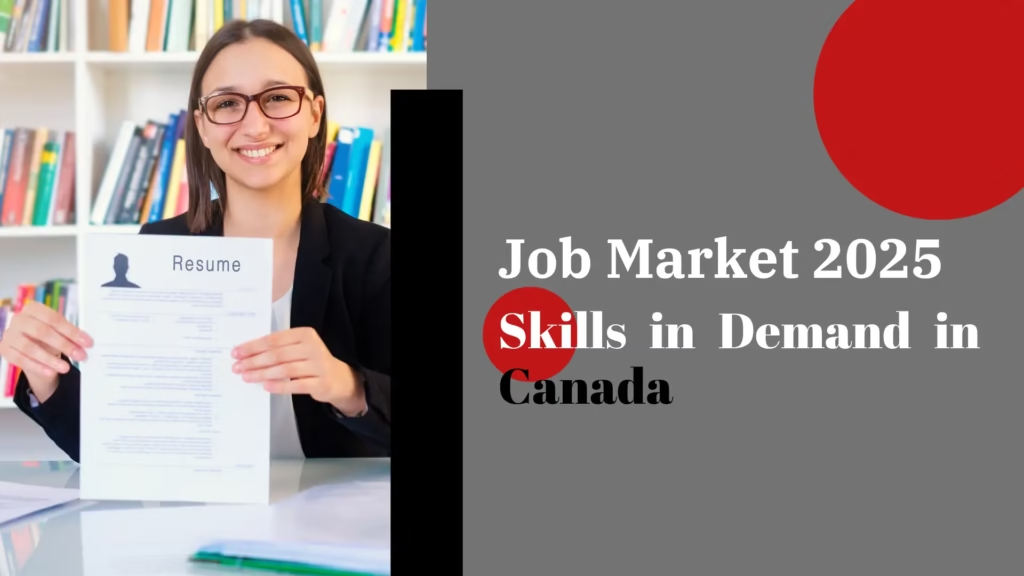
As your trusted partner in Canadian career development, the team at OMY Resumes brings you a forward-looking guide on how the job market in 2025 is evolving, which skills are most in demand, and how you can position yourself to succeed. Whether you’re seeking resume writing Canada support, resume services Toronto, or aiming for an ATS-friendly resume, this deep dive will equip you with insights and actionable strategies to thrive. Introduction The Canadian job market is undergoing rapid transformation. With technology innovation, demographic shifts and economic recovery reshaping hiring patterns, job seekers in cities like Toronto, Ottawa, Vancouver and Calgary face both opportunity and uncertainty. For 2025, understanding what employers want, beyond job titles, has never been more critical. If your current CV is not aligned with the trends, you may be missing callbacks, getting rejected by applicant-tracking systems, or unsure about your career path. Using the right skills, framing your professional narrative and ensuring your documents (resume, cover letter, LinkedIn profile) reflect market demand can make the difference. At OMY Resumes we specialise in resume writing Canada, LinkedIn optimisation and interview preparation, and this article will show how you can leverage that expertise for the 2025 job market. 1. Canadian Job Market Trends for 2025 1.1 Overview of growth and change 1.3 Data snapshot for major cities 2. Top Industries and Roles With Demand in 2025 2.1 Technology & IT 2.2 Healthcare & Life Sciences 2.3 Skilled Trades & Logistics 2.4 Marketing, Creative & Digital Media 2.5 Sustainability, Environment & Emerging Sectors 3. Core Skills in Demand for 2025 3.1 Hard Skills to prioritise 3.3 How to highlight these skills in your job search 4. Resumes That Win in 2025: Format, Keywords & Strategy 4.1 Make your resume ATS-friendly 4.2 Tailor for industry-specific resumes 4.3 Use story-driven accomplishment bullets Instead of generic bullets like “responsible for cloud migration”, write “Led a 10-person agile team to migrate 200+ servers to Azure cloud in six months, increasing uptime by 35% and reducing operating costs by CAD 120k annually”. That level of specificity speaks volumes. 4.4 Include certifications and continuous learning 4.5 Update your cover letter and LinkedIn to match 5. How to Future-Proof Your Career in Canada 5.1 Embrace continuous skill upgrades Given the pace of change in 2025 especially due to technology staying still means falling behind. Allocate time weekly for learning: online courses, hands-on projects, certifications. 5.2 Build your personal brand In Canada’s competitive markets (Toronto, Montreal, Vancouver) standing out counts. 5.3 Network strategically 5.4 Be prepared for shifting work models 5.5 Avoid common career missteps 6. Mistakes to Avoid in Your Job Search in 2025 6.1 Mistake: one-size-fits-all resume Sending the same resume to every role will hurt your chances. Tailor the document by role, industry and company keywords. 6.2 Mistake: ignoring ATS and keyword logic If your resume is scanned by a system and your skills don’t map to the role, you may never reach a human recruiter. 6.3 Mistake: listing tasks not outcomes Many candidates list what they did (“managed database”), not how well they did it (“optimised database to reduce query time by 40%”). Focus on outcomes. 6.4 Mistake: neglecting LinkedIn and digital footprint In 2025, recruiters expect to check your LinkedIn. A weak profile may undermine your strong resume. 6.5 Mistake: not addressing future skills Roles are evolving if your resume shows only old-school tools, you may appear outdated. Highlight tools like cloud, analytics, agile methods. 7. Step-by-Step Strategy for Canadian Job Seekers Step 1: Self-Audit your skills and interests Step 2: Choose your target role and industry Pick one or two roles for example, “Cloud engineer in Toronto” or “Digital marketing manager in Vancouver”. Use relevant internal pages like our Step 3: Update your resume and cover letter Step 4: Optimise your LinkedIn Step 5: Network and engage Step 6: Prepare for interviews Step 7: Monitor market trends and adjust 8. Mini-Case Studies Case Study 1: Tech pivot in Toronto Sarah was working in customer support but saw growth in cloud and DevOps roles in the GTA. She: Case Study 2: Healthcare professional in Vancouver Mark is an RN in Vancouver looking to move into care-coordination and telehealth. He: 9. Specific Skills You Can Acquire This Year Here are high-impact skills to pick up in 2025: 10. How OMY Resumes Can Help You Thrive At OMY Resumes our services are tailored to help you navigate the 2025 Canadian job market: Conclusion The job market in Canada in 2025 is dynamic, competitive and loaded with opportunity. But to capitalise on it you must align with the trends know which skills are in demand, craft resumes that pass ATS filters, build a strong LinkedIn presence and continually upskill. Whether you are aiming for a tech role in Toronto, a healthcare role in Vancouver, or looking to reposition into marketing or trades, the key is clarity, relevance and strategic execution. If your current job search isn’t delivering results, it may be time to refresh your approach. Ready to stand out in the competitive Canadian job market? Our Resume Writing Service team creates ATS-friendly resumes that land interviews faster. Book your free consultation today and let us help you succeed.
Resume Refresh: How Often Should You Update It?

IntrodutionIn Canada’s increasingly competitive job market of 2025, keeping your resume current is no longer optional—it’s essential. Whether you’re located in Toronto, Vancouver, Calgary, Ottawa or elsewhere, employers and recruiters are scanning resumes with ever-sharper filters. The latest statistics from Statistics Canada show job vacancies falling and unemployment creeping upward, creating more competition for each role. For job seekers relying on strong documents—be it a resume for entry-level roles, a mid-career shift, or an executive move—knowing when and how to update your resume matters. Updating isn’t just about adding your latest job or project: it’s about aligning with ATS-friendly practices (so your resume passes automated filters), integrating LinkedIn optimisation, and tailoring for industry-specific roles (IT, Healthcare, Finance, Engineering). In this article we’ll guide you through what signs indicate your resume needs a refresh, how often you should update it, and provide practical steps to keep your job search documentation top-tier. We’ll cover trends like AI resumes and ChatGPT for resumes, mistakes to avoid, Canadian job market context, and more. H2: Why Regular Resume Updates Matter in 2025 H3: The Canadian job market’s current state H3: Evolving hiring practices and resume standards H2: How Often Should You Refresh Your Resume? H3: Quarterly check-ins Every 3-4 months you should open your resume and ask: H3: Major life- or career-changes trigger a full update You should undertake a comprehensive revision when any of the following occur: In those cases your resume needs more than an edit—it likely needs a restructure. H3: Annual deep refresh At least once a year, treat your resume as a marketing document: Even if you are not job-hunting actively, this “maintenance” keeps you ready for unexpected opportunities. Signs Your Resume Needs a Refresh Right Now You’re getting no callbacks or responses If you’ve applied for multiple roles over the past few months and no one is contacting you, it could be your resume is not aligning with ATS systems or with recruiter expectations. Statistics suggest that fewer than 3 % of resumes submitted get a job interview.Actionable tip: Review your resume against the job postings you applied to. Does it use the same keywords? Is the format readable by ATS? If not—it’s time for a refresh with help from a professional service like our page. Your skills, tools or certifications have changed Maybe you added a certification in cloud computing, completed a major project using AI tools or transitioned from generalist to specialist (e.g., Marketing to Digital Analytics). Your resume needs to reflect that immediately—otherwise recruiters will assume you haven’t evolved.Example: Jane, a financial analyst in Toronto, earned a CFA L2 and completed a data-visualisation certification in Q1. She did not update her resume. When she applied for a senior role she got no responses. After updating the resume with the new certifications, keywords (data-visualisation, CFA L2) and adjusting the job title, she secured 5 interviews in 3 weeks. Role descriptions use old or passive language Resume trends show candidates are moving away from generic lines like “results-oriented professional seeking to leverage skills for company success” and toward action-driven summaries and skills mapping.Tip: Replace weak verbs (managed, responsible for) with strong impact statements (increased revenue by X %, reduced process time by Y %).If your resume still reads like a job description from 2015—it’s due for a rewrite. Your LinkedIn profile and resume aren’t aligned In Canada recruiters often cross-check your LinkedIn profile. If your resume lists your title as “Marketing Coordinator” but LinkedIn says “Marketing Manager” and your stories differ—you lose credibility.Ensure your resume and LinkedIn summary reflect the same data, you have links to your service, and any keywords are repeated. Per resume trends in 2025, inclusion of professional social network profiles is increasingly standard. You’re targeting a new industry or senior role If you are moving from mid-level to senior, or switching sectors (IT to Finance, Healthcare to Management), your resume needs to shift accordingly. It must emphasise leadership, strategy, outcomes. Generic resumes won’t cut it.Example: Sam moved from “Systems Analyst, IT” to “Business Systems Manager, Healthcare”. He rewrote his resume with relevant healthcare keywords, eliminated irrelevant IT-gaming projects, added new terminology (EHR, patient-data compliance) and changed the summary. The old resume got ignored; the new one generated multiple recruiter call‐backs. ATS scans are failing or formatting issues arise If you’ve run your resume through an ATS checker (or used a resume builder) and got flagged for formatting issues (tables, images, graphic elements), or you notice the PDF doesn’t display properly on mobile—the document needs updating.Canadian recruiters expect a clean format with proper fonts, no images that break parsing. You haven’t updated in more than a year Even if you’re not actively job-searching, your resume should still be “current”. After a year major changes can slip through: new project, new skills, evolving target role.Set a calendar reminder: “Resume review day” each year. Step-by-Step Guide to Refreshing Your Resume Step 1 Revisit your career story and target Step 2 Update your experience and achievements Step 3 Refresh your skills and credentials section Step 4 Format for readability and ATS Step 5 Tailor for each application Step 6 Update and align your online presence Step 7 Final review and backup Resume Trends for 2025 and What They Mean for Your Refresh AI-Optimised Resumes & ATS Friendly Industry-Specific Resumes Matter LinkedIn alignment & Branding Mistakes to Avoid When Refreshing Your Resume Forgetting to customise for location Canadian job markets vary by region: Toronto vs Calgary vs Vancouver vs Montreal. If you list old location info or irrelevant province, recruiters may discard you.Tip: Update your location (city & province) if you’ve moved. If open to relocation, mention “Open to relocation Canada-wide”. Over-relying on generic templates Generic one-size-fits-all templates may look nice but often fail ATS testing or lack clarity. Use templates suited for your role and industry (see our for examples).Mistake: Using a template with heavy graphics, multiple columns—may break parsing. Failing to remove irrelevant or outdated information Keeping old jobs from 20 years ago, irrelevant hobbies or early
